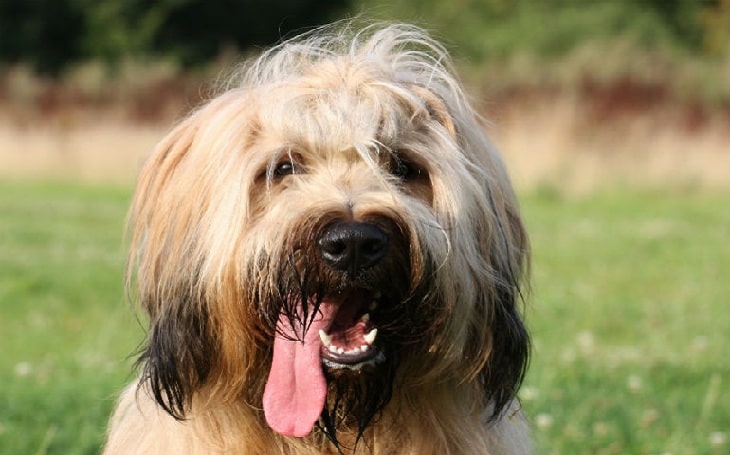Briard Dog Breed Information
General Information
| Dog Name | Briard |
|---|---|
| Other Names | Berger de Brie |
| Scientific Name | Canis lupus familiaris |
| Breed Type | Working |
| Group | Herding |
| Extinct | No |
| Country of Origin | France |
Physical And Size
| Min Life Span | 10 |
|---|---|
| Max Life Span | 12 |
| Min Ideal Weight for male | 28 |
| Max Ideal Weight for male | 38 |
| Min Ideal Weight for female | 22 |
| Max Ideal Weight for male | 38 |
Ranking
| Intelligent Rank | |
|---|---|
| Trainability | |
| Playfulness | |
| Affection Level | |
| Social Needs | |
| Barking | |
| Watchdog Ability | |
| Territorial | |
| Mouthiness | |
| Adaptability |
Characterisitics
| Temperament | Alert, Courageous, Loyal |
|---|---|
| Prey Drive | No |
| Fighting Dog | No |
Friendliness
| Stranger Friendly | Low |
|---|---|
| Child Friendly | High |
| Cat Friendly | Medium |
| Apartment Friendly | Medium |
| Senior Citizens Friendly | Medium |
| Service Dog | Medium |
| Search and Rescue Dog | Medium |
| Biting Potential | Medium |
| Country of Origin | France |
| Nicknames and Other Names | Berger Briard Berger de Brie |
| Scientific Name | Canis lupus familiaris |
| Breed Type | Purebred |
| Group | Herding Group Working Group |
| Bred For | Herding cattle |
| Size | Large-sized |
| Recognized By | AKC, UKC, CKC, ANKC, NZKC, CKC, KC |
| Life Span | 12 years |
| Ideal Weight | 55-100 pounds (male and female) |
| Ideal Height | Male: 23-27 inches Female: 22-25.5 inches |
| Fur Type | Long, slightly wavy, dense |
| Common Colors | Black, Tawny, Gray |
| Markings | White markings |
| Availability | Moderately available |
| Achievements | Used as a police dog |
| Suitable for Apartments | No |
| Used in World War | Used in World War I by the French army as a sentry and messenger |
| Most Similar To | Schapendoes |
Briard dog is a large-sized dog that was originated in France. It has an alert and handsome appearance. It is a herding dog that has a high activity level is suited in an apartment as long as it gets the required amount of exercise.
Briard has a strong body with a large head that is covered with flowing hair. The ears are erect, giving them an alert expression. The coat is silky, long, and straight.
Origin and History
Briard was bred to be a herding dog and also the guardian of the flocks. It is also known as Chien Berger de Brie in its homeland. It was known for its bravery that could even fight wolves to defend the livestock.
Briard was introduced to the United States by Thomas Jefferson and the Marquis de Lafayette. Jefferson even said that Briard is the finest house and farm dogs he has ever seen.
The American Kennel Club recognized Briard in 1928 as a member of the herding group. It currently ranks 132 of 193 AKC registered breed.
Is Briard Child-Friendly?
Briard is very tolerant of children and does not mind their rough behavior if raised together. They are very protective of them and are always by their side guarding. However, with strange children, they tend to herd them by nipping at the heel. So, while taking them out to a place with lots of children, always keep them on a leash.

Image Source: Instagram-4paws4harrison
Temperament, Behavior, and Personality
Temperament: The temperament of the Briard is brave, alert, and faithful. They are very alert of the activities going on in the surrounding. Therefore, they make an excellent watchdog and also a guard dog. Protective of their family, they are not afraid to face anything while defending its people.
Behavior: As a herding dog and guarding dog, Briard to herd small animals sometime and chase them around. However, they are also protective of the pets at home and will look after them like a big brother.
Personality: The personality of the Briard is smart, friendly, and lively. They are very playful and friendly with their family and make a great companion for an active family. They are smart and are quick at learning new instruction or commands.
Trainability
Training Briard needs patience and firm leadership. Establish leadership on them when they are still young, so they see you as their leader and follow you. They tend to respond well to positive reinforcement, so reward them with delicious treats and use lots of vocal praises as the source of motivation and encouragement.
Never be harsh on them or use force hand. It will only lead to their aggression and they can even bite you. Train them with gentleness even if they make some mistakes.
Facts
- Briard dogs were used in World War I as a service dog that used to supply medicines and also work as a messenger.
- Marquis de Lafayette was the person who introduced Briard to Thomas Jefferson and he, to the United States.
Health Issues
| General Health | Healthy |
| Common Health Issues | bloat, Obesity, Hip Dysplasia, Diabetes, Heart Disease, Patellar Luxation, Elbow Dysplasia |
| Hypoallergenic | No |
| Vaccination Required | Rabies, Kennel Cough, Canine Coronavirus, Canine Distemper, Canine Parvovirus, Leptospirosis, Canine Parainfluenza |
| Shedding | Moderate |
| Drooling | Low |
| Grooming | Hard and regularly required |
| Weight Gain Potential | Average |
| Separation Anxiety | High Chance |
| Allergies | None |
| Diets and Supplements | Protein: 25%-30% Fat: 8% Glucosamine Probiotics |
The Briard is usually a healthy breed with only a few possible health problems.
- Hip Dysplasia: It is a condition where your dog feels a sharp pain on its pack causing it painful to move from one place to another. It may be a genetic cause that happens due to dislocation or underdeveloped of the hip joints. Consult a vet for proper treatment.
- Obesity: Obesity is caused due to overfeeding. Your dog gets fat and the extra weight that it gains caused obesity. It also invites many other bones and joints. So, do not overfeed your dog as it is bad for the health of your dog.
Colors
The Briard comes in following colors and markings.
- Black
- Gray
- Brindle
- Black and Gray
- Tawny
- Black and Tawny
- White
- Tawny and Gray
- White markings
Puppies

Image Source; AKC marketplace
Size: The average height of the Briard is between 22-27 inches and the average weight is between 55-100 pounds.
Cost: The average cost of the Briard is between $1000-$1200 USD.
Similar Dog Breeds to Briard
Visit Doglime for more information about dog breeds history, behavior, and
Tags











2 thoughts on “Briard Dog Breed Information”